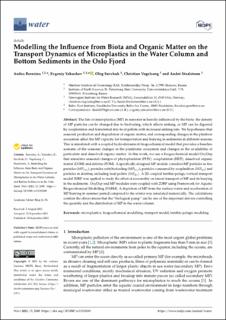| dc.contributor.author | Berezina, Anfisa | |
| dc.contributor.author | Yakushev, Evgeniy | |
| dc.contributor.author | Savchuk, Oleg | |
| dc.contributor.author | Vogelsang, Christian | |
| dc.contributor.author | Staalstrom, André | |
| dc.date.accessioned | 2021-10-27T08:39:34Z | |
| dc.date.available | 2021-10-27T08:39:34Z | |
| dc.date.created | 2021-10-15T15:15:01Z | |
| dc.date.issued | 2021 | |
| dc.identifier.citation | Water. 2021, 13 (19), 2690. | en_US |
| dc.identifier.issn | 2073-4441 | |
| dc.identifier.uri | https://hdl.handle.net/11250/2825892 | |
| dc.description.abstract | The fate of microplastics (MP) in seawater is heavily influenced by the biota: the density of MP particles can be changed due to biofouling, which affects sinking, or MP can be digested by zooplankton and transferred into fecal pellets with increased sinking rate. We hypothesize that seasonal production and degradation of organic matter, and corresponding changes in the plankton ecosystem affect the MP capacity for transportation and burying in sediments in different seasons. This is simulated with a coupled hydrodynamical-biogeochemical model that provides a baseline scenario of the seasonal changes in the planktonic ecosystem and changes in the availability of particulate and dissolved organic matter. In this work, we use a biogeochemical model OxyDep that simulates seasonal changes of phytoplankton (PHY), zooplankton (HET), dissolved organic matter (DOM) and detritus (POM). A specifically designed MP module considers MP particles as free particles (MPfree), particles with biofouling (MPbiof), particles consumed by zooplankton (MPhet) and particles in detritus, including fecal pellets (MPdet). A 2D coupled benthic-pelagic vertical transport model 2DBP was applied to study the effect of seasonality on lateral transport of MP and its burying in the sediments. OxyDep and MP modules were coupled with 2DBP using Framework for Aquatic Biogeochemical Modelling (FABM). A depletion of MP from the surface water and acceleration of MP burying in summer period compared to the winter was simulated numerically. The calculations confirm the observations that the “biological pump” can be one of the important drivers controlling the quantity and the distribution of MP in the water column. | en_US |
| dc.language.iso | eng | en_US |
| dc.publisher | MDPI | en_US |
| dc.rights | Navngivelse 4.0 Internasjonal | * |
| dc.rights.uri | http://creativecommons.org/licenses/by/4.0/deed.no | * |
| dc.title | Modelling the influence from biota and organic matter on the transport dynamics of microplastics in the water column and bottom sediments in the Oslo fjord | en_US |
| dc.type | Peer reviewed | en_US |
| dc.type | Journal article | en_US |
| dc.description.version | publishedVersion | en_US |
| dc.rights.holder | © 2021 by the authors. | en_US |
| dc.source.pagenumber | 19 | en_US |
| dc.source.volume | 13 | en_US |
| dc.source.journal | Water | en_US |
| dc.source.issue | 19 | en_US |
| dc.identifier.doi | 10.3390/w13192690 | |
| dc.identifier.cristin | 1946290 | |
| dc.source.articlenumber | 2690 | en_US |
| cristin.ispublished | true | |
| cristin.fulltext | original | |
| cristin.qualitycode | 1 | |

